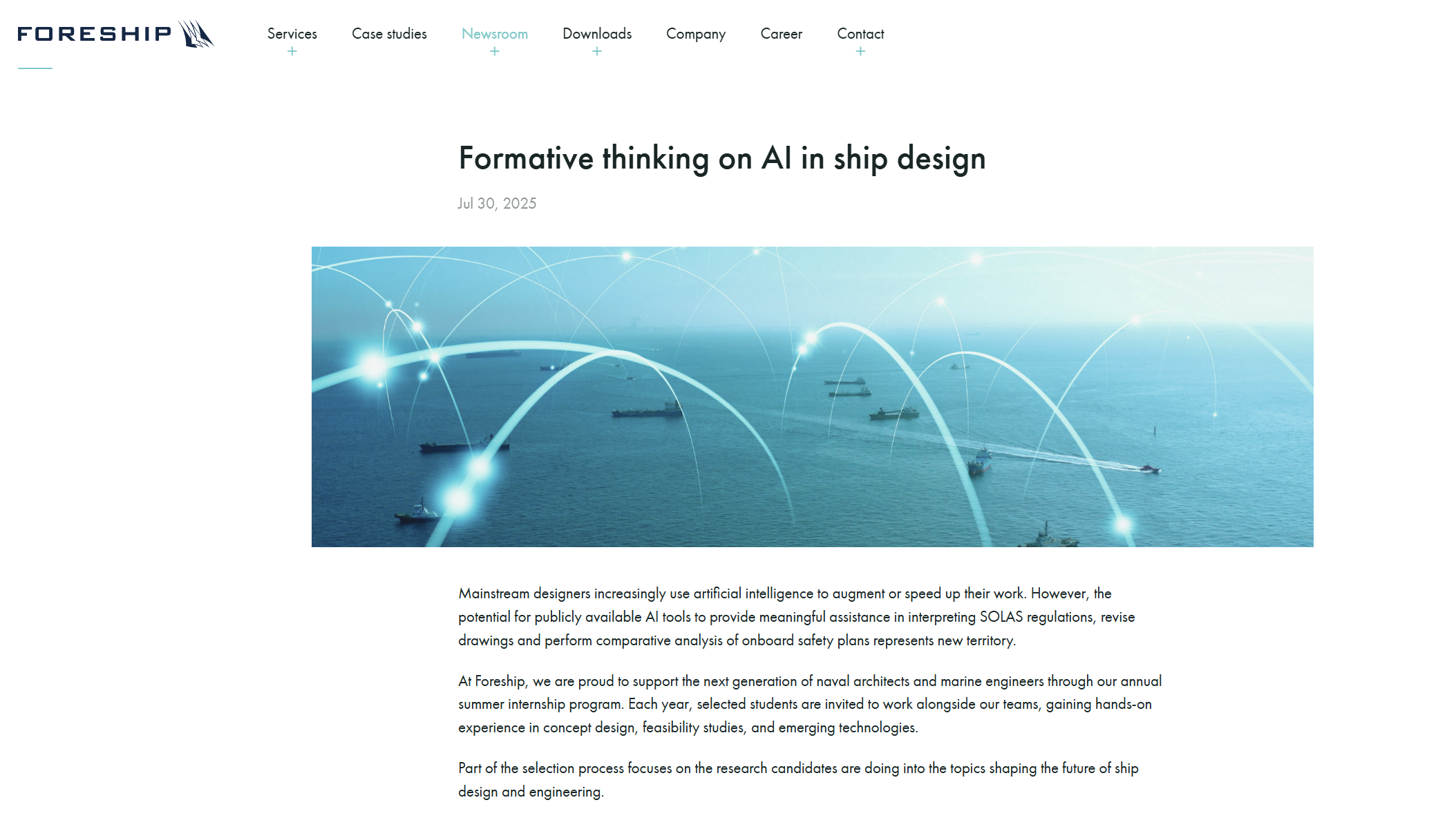Formative thinking on AI in ship design
Photo: Foreship
Mainstream designers increasingly use artificial intelligence to augment or speed up their work. However, the potential for publicly available AI tools to provide meaningful assistance in interpreting SOLAS regulations, revise drawings and perform comparative analysis of onboard safety plans represents new territory.
At Foreship, we are proud to support the next generation of naval architects and marine engineers through our annual summer internship program. Each year, selected students are invited to work alongside our teams, gaining hands-on experience in concept design, feasibility studies, and emerging technologies.
Part of the selection process focuses on the research candidates are doing into the topics shaping the future of ship design and engineering.
Among the three master’s thesis interns this year was Santeri Korpela – who recently graduated in Mechanical Engineering at Turku University of Applied Sciences. Santeri has subsequently been hired by Foreship as a project engineer working in its Interior Department, and his thesis exploring the potential for AI as a support tool for ship design merits further study.
For one thing, the findings are clear: while AI cannot yet take over the work of a trained designer, certain tools already offer support in specific areas — particularly when it comes to comparing versions of drawings and interpreting tabulated data, Santeri concludes.
His investigation assesses three large language model (LLM)-based tools. Each was tested on its ability to read and interpret SOLAS chapter 2.2; answer technical questions derived from its rules; identify discrepancies between design drawings; and attempt visual outputs based on rule compliance. Drawing types used in the study included Fire Control Plans (FCP), Structural Fire Protection Plans (SFPP), and Escape Plans - all documents that are typically rule-heavy, visually detailed, and subject to strict safety requirements.
The study found that all three tools handled text and numerical interpretation well, particularly when given smaller, rule-specific tasks. The first tool stood out for its ability to generate visual comparisons between drawings and detect differences between design versions. The second tool, on the other hand, performed best when reading tables and identifying numerical patterns. The third tool proved the most limited, struggling with visual tasks and delivering inconsistent results when interpreting regulation-based questions.
Significantly, none of the AI tools could revise or generate rule-compliant design drawings from scratch. Tasks that required applying SOLAS tables to determine and verify boundary types - such as identifying whether a given interface requires A- or B-class insulation, and further specifying the exact fire rating, such as A-30 or B-15 - proved too complex.
Even after extended training, the tools missed obvious errors, skipped elements entirely, or failed to follow the rule tables precisely. That said, the tools were often helpful in cross-checking individual requirements or suggesting what information a given plan should contain.
When applied to escape plans, AI showed greater promise. Two of the tools produced useful summaries of differences between evacuation routes and stairwell loadings, identifying how numerical values changed across revisions. These insights could be helpful to inspectors reviewing plan modifications or reconciling alternative layouts.
“The results were encouraging but realistic,” Santeri summarized in his thesis. “AI tools today can serve as a limited assistant, particularly in verifying table-based requirements and comparing visual revisions. But for now, they fall short of being able to revise or create compliant drawings independently.”
Foreship’s Head of New Technologies, Joonatan Haukilehto, agrees that the findings offer a valuable snapshot of AI’s current capabilities: “We see great potential in AI as a long-term aid to designers, but it’s not a substitute for expertise. Our responsibility is to monitor these developments closely and test them rigorously, so we know when they’re ready to contribute meaningfully.”
Santeri’s full thesis runs to over 90 pages and includes detailed screenshots, test results, and methodology. His work aligns with a wider exploration at Foreship into how AI and automation might complement its core design services in the years ahead.

